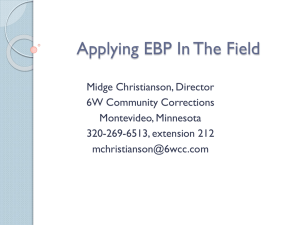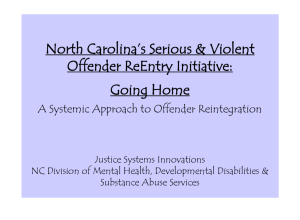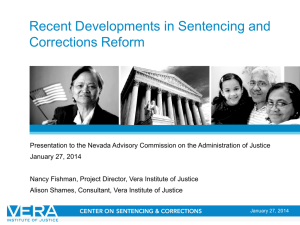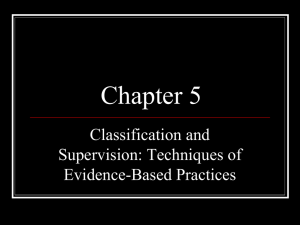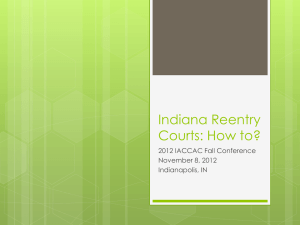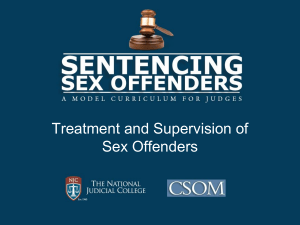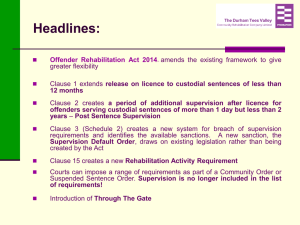SPR Framework Transition Accountability
advertisement
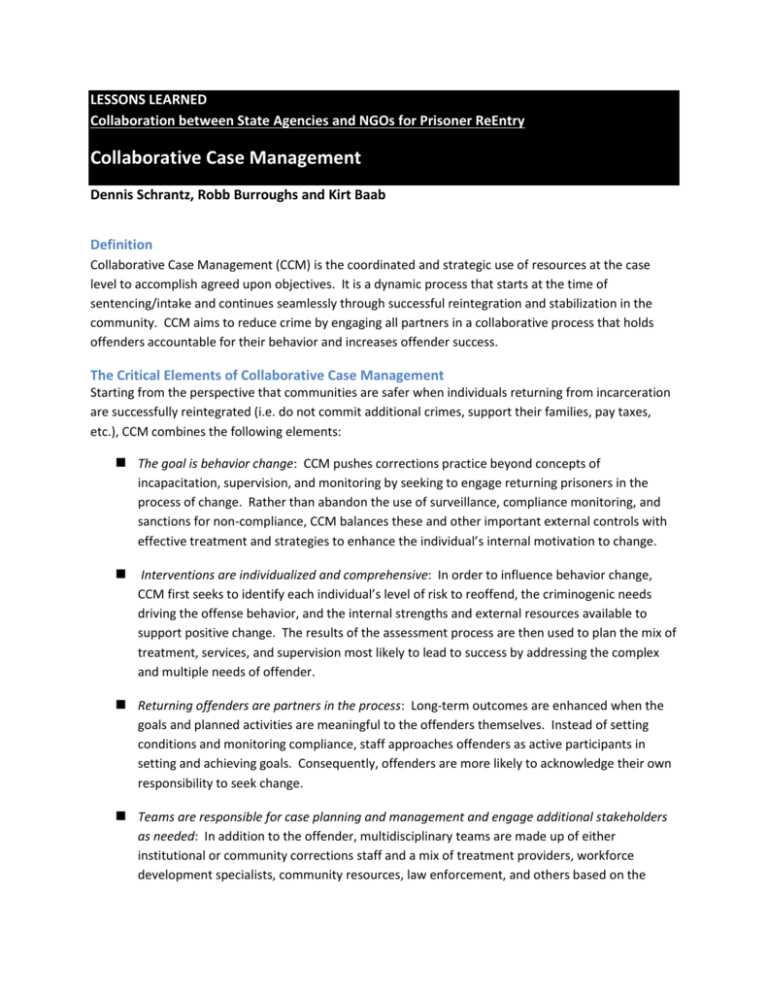
LESSONS LEARNED Collaboration between State Agencies and NGOs for Prisoner ReEntry Collaborative Case Management Dennis Schrantz, Robb Burroughs and Kirt Baab Definition Collaborative Case Management (CCM) is the coordinated and strategic use of resources at the case level to accomplish agreed upon objectives. It is a dynamic process that starts at the time of sentencing/intake and continues seamlessly through successful reintegration and stabilization in the community. CCM aims to reduce crime by engaging all partners in a collaborative process that holds offenders accountable for their behavior and increases offender success. The Critical Elements of Collaborative Case Management Starting from the perspective that communities are safer when individuals returning from incarceration are successfully reintegrated (i.e. do not commit additional crimes, support their families, pay taxes, etc.), CCM combines the following elements: The goal is behavior change: CCM pushes corrections practice beyond concepts of incapacitation, supervision, and monitoring by seeking to engage returning prisoners in the process of change. Rather than abandon the use of surveillance, compliance monitoring, and sanctions for non-compliance, CCM balances these and other important external controls with effective treatment and strategies to enhance the individual’s internal motivation to change. Interventions are individualized and comprehensive: In order to influence behavior change, CCM first seeks to identify each individual’s level of risk to reoffend, the criminogenic needs driving the offense behavior, and the internal strengths and external resources available to support positive change. The results of the assessment process are then used to plan the mix of treatment, services, and supervision most likely to lead to success by addressing the complex and multiple needs of offender. Returning offenders are partners in the process: Long-term outcomes are enhanced when the goals and planned activities are meaningful to the offenders themselves. Instead of setting conditions and monitoring compliance, staff approaches offenders as active participants in setting and achieving goals. Consequently, offenders are more likely to acknowledge their own responsibility to seek change. Teams are responsible for case planning and management and engage additional stakeholders as needed: In addition to the offender, multidisciplinary teams are made up of either institutional or community corrections staff and a mix of treatment providers, workforce development specialists, community resources, law enforcement, and others based on the specific needs of each offender. The team frequently reaches out and coordinates services with other stakeholders, including family, faith-based groups, and other natural supports. Transitions are seamless: In order to ensure continuity of key treatment and services, especially those that start inside the facility and continue in the community, teams managing cases inside the facility and teams managing cases in the community communicate and coordinate activities. The primary tool for case-level communication and coordination is the Transition Accountability Plan (TAP). Collaborative Case Management Policy and Practice The elements of CCM can be translated into more specific policy and practice guidelines for improving reentry outcomes. The numbered headings are the six core activities for implementation of the collaborative case management model described in Chapter 5 of the TPC Reentry Handbook. Each is followed with a brief discussion of policy and procedure recommendations that support implementation of the core activity. RESOURCES Report of the Re-Entry Policy Council: Policy Statement 8 – Development of Intake Procedure Prisoner Reentry Initiative Coaching Packet: Effective Case Management Putting Public Safety First: 13 Parole Supervision Strategies to Enhance Reentry Outcomes: Strategy 8 – Assess Criminogenic Risk and Need Factors Report of the Re-Entry Policy Council: Policy Statement 5 – Promoting Systems Integration and Coordination Policy Statement 25 – Design of Supervision Strategy 1. Conduct assessments of offenders’ risks, needs, strengths, and environment. CCM activity should start at the point of intake to the facility with a comprehensive assessment process. The goal is to build awareness of the personal, situational, and historical/contextual factors behind each offender’s criminal justice involvement, as well as his or her strengths that can be accessed to mediate risk. The focus of the assessment process should be validated measure of risk and criminogenic need but should also include multiple screenings and further assessment, as indicated, for a full range of personal history and needs, including but not limited to health, mental health, family relationships, employment, and housing stability. Because gathering all of the necessary information will require the use of generalized risk and need assessments, screenings, and follow-up assessments, facility policy should define a streamlined process for selecting, administering, and tracking assessments. In addition, the staff administering assessments should be properly trained and supervised and use instruments that have been validated. Although the most extensive and intensive assessment work may take place at the point of intake, policies and procedures should be in place for reassessment throughout the entire reentry process. Reassessment allows the team to uncover new or evolving needs and to track changes in dynamic criminogenic needs following delivery of treatment, programming, and other interventions. 2. Form, participate in, and lead case management teams that work collaboratively. Throughout all three phases of reentry, case planning and management activities are conducted by an interdisciplinary team called a transition team. The composition of the transition team and the respective roles of its members will change over time, as the offender completes goals, identifies new needs, and transitions through the three phases. Generally, the team should include the offender, prison staff, community supervision staff, facility and community-based service providers, and family members and/or pro-social supports. During the institutional phase prison staff may lead the team. During the reentry Policy Statement 26 – Implementation of Supervision Strategy Prisoner Reentry Initiative Coaching Packet: Engaging in Collaborative Partnerships to Support Reentry Putting Safety First: 13 Parole Supervision Strategies to Enhance Reentry: Strategy 7 – Engage Partners to Expand Intervention Capacities Report of the Re-Entry Policy Council: Policy Statement 9 – Development of Programming Plan Policy Statement 17 – Advising the Releasing Authority Policy Statement 25 – Design of Supervision Strategy Effective Case Planning Strategies (webinar) Putting Safety First: 13 Parole Supervision Strategies to Enhance Reentry: Strategy 9 – Develop and Implement Supervision Case Plans that Balance Surveillance and Treatment and community supervision phase parole officers may lead the team. During the reintegration phase human services agencies or community services providers may lead the team. In order to facilitate effective and efficient transition team operation, policies should be in place to define team composition, member roles and responsibilities, and the content and process of information sharing between team members. It is also important to ensure that staff members responsible for case management have the knowledge, skills, and time to carry out new and likely more intensive activities. Creating adequate staff capacity may mean removing or reducing prior staff responsibilities that are no longer needed. Whenever personal information is shared, it is critical to maintain the offenders’ rights to confidentiality. However, with appropriate consent, information sharing across agency boundaries is necessary for good assessment and case management. One way to facilitate the exchange of information between agencies and systems is to share access and even link information technology systems in use by the respective service systems (i.e. corrections, mental health, human services, etc.). Again, the technology should include safeguards to ensure that information identified with a specific individual can only be accessed by members of the team who have been authorized to view that information. 3. Develop and implement – along with offenders and other partners within both correctional and other agencies – a transition accountability plan geared directly to the level of offender risk and criminogenic needs. The transition accountability plan (TAP) is a concise guide for the offender and case management team that describes the goals identified for each offender’s successful transition and the schedule of actions that need to be taken by the offender, prison staff, releasing authority, community supervision staff, partnering agencies, and others to achieve those goals. The increased certainty and clarity of goals and activities will motivate offenders to participate in the case management process and fulfill their responsibilities. Likewise, the TAP will ensure that all parties are held accountable for timely performance of their respective responsibilities. The TAP spans the three phases of the transition process, as well as agency barriers, to ensure continuity of care between the institution and the community. At a minimum, the TAP should be formally updated at four critical junctures in the reentry process: TAP1: The Prison Programming Plan – Completed at intake, the TAP1 includes the expectations for the prison term that will help inmates prepare for release. TAP2: The Parole Plan and Reentry Plan – Completed prior to release, the TAP 2 describes the terms, conditions, and expectations about the prisoners release to communities. TAP3: The Treatment and Supervision Plan – Completed upon return to the community, the TAP 4 includes a detailed schedule of the supervision and services offenders will experience in the community. TAP4: The Discharge and Aftercare Plan – Completed prior to successful discharge from parole/probation, the TAP4 describes how the offender will maintain longterm success in the community with the support of community service agencies and informal prosocial supports. Figure 3.1 on the next page illustrates the use of the TAP through the points of the reentry process. FIGURE 3.1 SPR Framework Transition Accountability Planning (TAP) Flowchart PHASE 1: GETTING READY The Institutional Phase PHASE 2: GOING HOME The Transitional Phase TAP2: Parole & Reentry Plan TAP1: Prison Programming Plan Assessment & Classification Inmate Programming PHASE 3: STAYING HOME The Community Phase Inmate Release Preparation TAP3: Treatment & Supervision Plan Supervision & Services Release Decision Making Revocation Decision Making Transition Team Meetings (Monthly): Attended by transitional planners, probation/ parole reps, service providers, offender, and his/her family TAP4: Discharge & Aftercare Plan Discharge & Aftercare Transitional Planners: Work with offenders while they are incarcerated preparing them for release and continue to work as partners with probation and parole for as long as one year after release. RESOURCES Report of the Re-Entry Policy Council: Policy Statement 14 – Behaviors and Attitudes Policy Statement 27 – Maintaining Continuity of Care Policy Statement 9 – Development of Programming Plan (pp. 141 – 153) Policy Statement 14 – Behaviors and Attitudes (pp. 201 – 210) Policy Statement 26 – Implementation of Supervision Strategy (pp. 358 – 369) Putting Safety First: 13 Parole Supervision Strategies to Enhance Reentry: Strategy 10 - Involve Parolees to Enhance their Engagement in Assessment, Case Planning, and Supervision Report of the Re-Entry Policy Council: Policy Statement 26 – Implementation of Supervision Strategy Policy Statement 29 – Graduated Responses Putting Safety First: 13 Parole Supervision Strategies to Enhance Reentry: 4. Provide or facilitate access to programs and interventions to address risk and needs. In addition to the role members of the transition team will play in delivering direct services, including assessment, treatment, and motivational enhancement, at various points, the transition team will also fill a referral and brokerage role. The two complimentary roles ensure that offenders have access to treatment, programming, and interventions that will effectively address risk and needs. Interventions should be consistent with the principles of evidence-based practice. 5. Involve offenders in the case management process and engage them in the process of change, making efforts to enhance their motivation. By engaging offenders in the assessment, planning, and case management process, CCM is more than a means of referring to and tracking participation in various treatment programs. It is an intervention on its own, complimenting and enhancing the outcomes of other interventions. The evidence is strong that offenders are more likely to achieve and sustain desired behavior changes if the goals and process for achieving the goals are meaningful for them. One way to build this intrinsic motivation is to involve offenders as the central member of the transition team when conducting assessment, planning, and progress monitoring. It is not enough just to ask for his or her feedback from time to time. The team should seek to build a trusting relationship with the offender through regular and consistent contact, including both formal meetings and less formal check-ins, such as a conversation during meal time at the facility or a home visit in the community. Another, more direct means to enhance motivation, is for members of the transition team to use communication styles and techniques designed to enhance motivation, such as Motivational Interviewing (MI), in all of their interactions with the offender. Rather than impose goals and demand solutions, these approaches employ empathy and specific communication skills to direct the offender through his or her own exploration of the need for change and identification of goals and solutions. Integrating MI and other approaches to enhance motivation into staff-offender interactions requires training and ongoing coaching for the staff, as well as policies and procedures that establish the value of these approaches. 6. Review progress and adapt plans accordingly over time, including monitoring conditions of supervision and responding appropriately to both technical and criminal violations. Through the use of formalized assessments, as well as frequent and consistent communication with the offender, members of the transition team, treatment providers, family members, and others engaged in the transition process, it is important to assess progress toward desired changes over time. When progress is slower than expected or there are indications that the offender is sliding back toward old problematic behavior patterns, a swift response to identify the problem and adjust the plan accordingly is needed. Conversely, faster than expected progress, compliance with facility expectations Strategy 12 – Incorporate Incentives and Rewards into the Supervision Process Strategy 13 - Employ Graduated ProblemSolving Responses to Violations of Parole Conditions in a Swift and Certain Manner and community supervision conditions, and other achievements should be acknowledged and rewarded, as appropriate, as a means to enhance motivation further. The transition team’s focus on monitoring and adjusting the transition plan is especially important in the period immediately following return to the community. Most people transitioning from the facility environment to the community experience some degree of anxiety and stress and need an adjustment period. The appearance of problem behaviors, especially during this adjustment, does not necessarily indicate a return to criminal behavior. It is important that community supervision officers have the skills to distinguish between the behaviors that are affiliated with a risk of future transgression and behaviors that are more likely associated with the adjustment. Regardless of the cause of the problem behavior and the potential risk it signals, the supervision officer and transition team should be equipped with a full range of responses, including graduated levels of sanctions, that can be used to facilitate compliance and encourage success. Ensuring the community’s safety is the top priority, and returning an individual to incarceration may be necessary in some cases to protect safety. However, as a default response to all violations, re-incarceration does little to change behavior patterns and protect safety over the long term.

